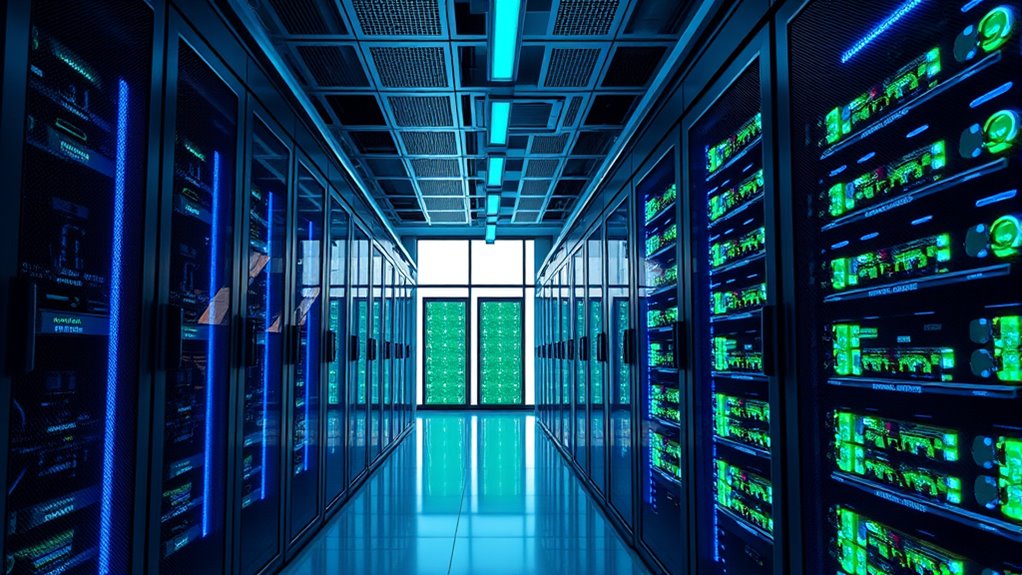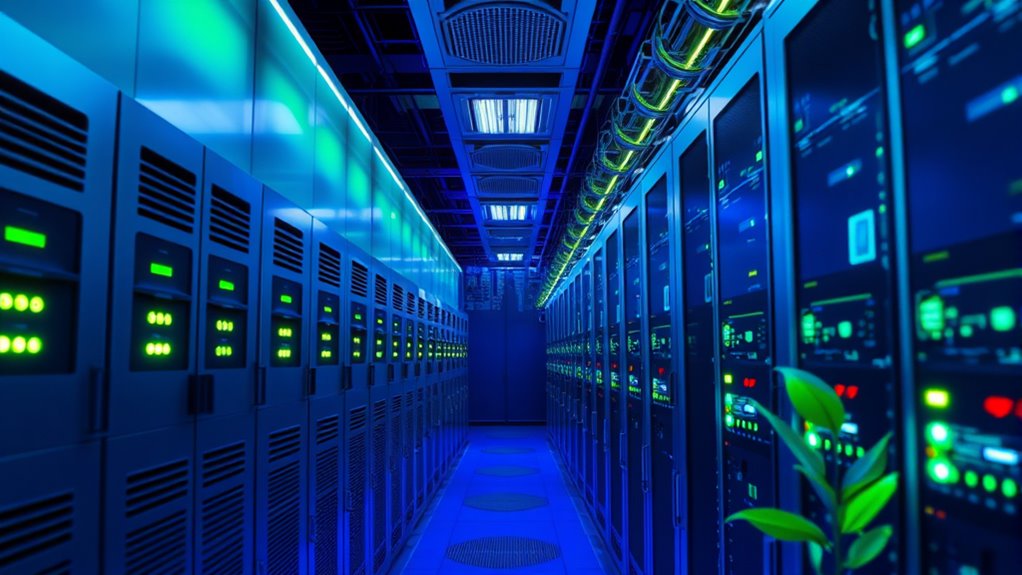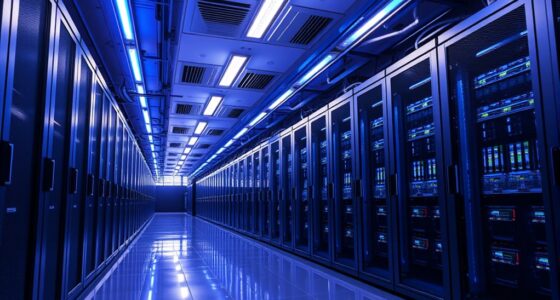To support sustainability, focus on energy-efficient AI hardware by choosing specialized chips like ASICs and energy-saving GPUs. Combining hardware improvements with software techniques such as pruning and quantization can markedly reduce power consumption. Integrating renewable energy sources into data centers, implementing green manufacturing practices, and deploying energy management systems further minimize environmental impact. Continuing to explore these innovations helps you understand how to make AI more eco-friendly and sustainable in your projects.
Key Takeaways
- Utilizing specialized hardware like ASICs and energy-efficient GPUs reduces power consumption during AI processing.
- Integrating renewable energy sources such as solar and wind minimizes reliance on fossil fuels for AI data centers.
- Implementing green manufacturing practices and sustainable materials lowers the environmental impact of AI hardware production.
- Software optimizations like model pruning and quantization decrease computational demands and energy use.
- Monitoring energy consumption and adopting innovative, eco-friendly technologies promote sustainable AI infrastructure management.

As artificial intelligence continues to advance, the energy consumption of AI hardware has become a critical concern for sustainability. Every computation, data processing, and model training demands significant power, often leading to a substantial carbon footprint. To address this, integrating renewable energy sources into AI operations is essential. By powering data centers and hardware with solar, wind, or hydropower, you can drastically reduce reliance on fossil fuels, making your AI initiatives greener and more sustainable. Renewable energy not only cuts emissions but also helps guarantee a more stable and predictable energy supply, especially as demand for AI grows. This shift toward renewable sources is a crucial component of green manufacturing practices, where the entire production and operation cycle prioritize environmental responsibility. Green manufacturing emphasizes designing and building AI hardware with minimal environmental impact, encouraging you to select sustainable materials and energy-efficient components. Implementing energy-efficient cooling systems, optimizing hardware layouts, and adopting modular designs contribute to reducing energy waste. These practices make your AI hardware more efficient and extend its lifespan, further supporting sustainability goals. Additionally, the rise of cybersecurity vulnerabilities during major outages underscores the importance of robust security measures in AI hardware infrastructure to prevent potential disruptions or attacks.
Integrate renewable energy and green manufacturing to make AI hardware more sustainable and eco-friendly.
You can also play a role by choosing AI hardware built with energy efficiency in mind. Manufacturers are now developing specialized chips—such as application-specific integrated circuits (ASICs) and energy-efficient GPUs—that deliver high performance while consuming less power. When you opt for these devices, you’re directly contributing to a reduction in overall energy consumption. Additionally, software optimization techniques like model pruning, quantization, and efficient algorithms help decrease computational load, leading to less energy use during training and inference. This combined hardware-software approach maximizes efficiency, ensuring you get the most out of your AI systems without unnecessary energy drain.
Furthermore, fostering a culture of sustainability involves continuously monitoring and managing energy consumption. You can deploy energy management systems that track usage patterns, identify inefficiencies, and suggest improvements. Regularly updating hardware and software to incorporate the latest energy-saving innovations ensures your AI infrastructure remains as eco-friendly as possible. As the industry advances, staying informed about emerging sustainable technologies and practices will enable you to make smarter decisions that align with your environmental commitments.
In essence, making AI hardware energy-efficient and environmentally sustainable isn’t just about adopting new technologies—it’s about embedding renewable energy and green manufacturing principles into your entire workflow. By doing so, you actively reduce your carbon footprint, promote responsible resource use, and contribute to a future where AI advances coexist harmoniously with the planet’s health. Your choices today can drive meaningful change, making AI development truly sustainable for tomorrow.
Frequently Asked Questions
How Does AI Hardware Impact Global Carbon Emissions?
AI hardware impacts global carbon emissions by consuming substantial energy during operation. When you optimize hardware through better hardware design and efficiency, you reduce energy use. Using renewable energy sources further decreases carbon footprint. Your efforts in hardware optimization and shifting to renewable energy can markedly lower AI’s environmental impact, helping to combat climate change. By making these choices, you contribute to a more sustainable and eco-friendly AI future.
What Are the Economic Benefits of Sustainable AI Hardware?
You’ll find that sustainable AI hardware offers significant economic benefits, such as cost reduction through lower energy bills and maintenance expenses. While some might doubt these savings, studies suggest they’re real. Plus, governments and companies often provide investment incentives for eco-friendly tech, boosting your potential profits. By adopting sustainable AI hardware, you not only save money but also position yourself as an innovative leader, gaining competitive advantages in the market.
How Can Consumers Identify Energy-Efficient AI Devices?
You can identify energy-efficient AI devices by checking their energy labeling, which indicates their power consumption and efficiency. Look for devices with clear benchmarking results that compare their performance to others. This way, you guarantee you’re choosing a device that consumes less energy while delivering quality performance. Always review labels and benchmarking data before making a purchase, so you can make an informed decision that supports sustainability and saves you money.
What Policies Promote Sustainable AI Hardware Development?
You should look for policies that promote sustainable AI hardware development, such as government incentives and industry standards. Governments often provide tax breaks or grants for companies adopting green practices, while industry standards set benchmarks for energy efficiency. By supporting these policies, you encourage innovation in eco-friendly AI hardware, helping reduce environmental impact. Staying informed about such policies guarantees you’re backing responsible development and making sustainable technology choices.
How Does AI Hardware Recyclability Contribute to Sustainability?
Recyclability of AI hardware boosts sustainability by supporting a circular economy, where materials are reused and repurposed rather than discarded. You can contribute by ensuring devices are designed for easy disassembly, making material recovery more efficient. This reduces waste, conserves resources, and minimizes environmental impact. By prioritizing recyclability, you help create a sustainable cycle that benefits both the planet and future technology development.
Conclusion
By adopting energy-efficient AI hardware, you reduce energy consumption, lower environmental impact, and promote sustainability. You optimize performance, cut costs, and support innovation. You embrace responsible technology, foster a greener future, and lead the way toward sustainable development. You see that efficiency drives progress, conservation preserves resources, and innovation empowers change. Ultimately, you realize that choosing sustainable AI hardware isn’t just an option; it’s a necessity for a better, brighter tomorrow.










